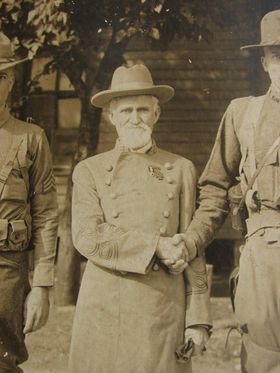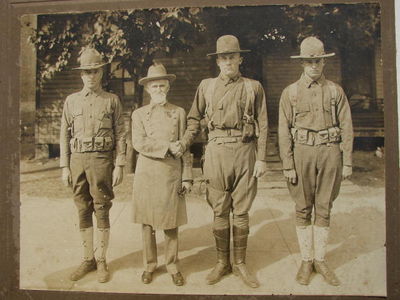Annotation:Yearlings in the Canebrake: Difference between revisions
No edit summary |
No edit summary |
||
| Line 1: | Line 1: | ||
{{TuneAnnotation | {{TuneAnnotation | ||
|f_tune_annotation_title= | |f_tune_annotation_title=https://tunearch.org/wiki/Annotation:Yearlings_in_the_Canebrake > | ||
|f_annotation='''YEARLINGS IN THE CANEBRAKE.''' AKA - "Yearlings in the Canebreak." American, Reel (cut time). A Dorian ('A' part) & A Major ('B' part). Standard tuning (fiddle). AABB'. The tune is known as a Southwest melody. It was recorded in the 78 RPM era by Captain M.J. Bonner [http://traildriver.com/web%20content/projects/texas/mj_bonner/mjbonner.html] (“The Texas Fiddler”), a Confederate Army veteran who recorded at the age of 78 in 1925. Bonner was born March 1, 1847, in Franklin County, Alabama, and his family migrated to Texas around 1854. He was the most accomplished old-time musician to play on the first radio station ‘barn dance’ broadcast on WBAP out of Fort Worth, Texas, on Jan. 24th, 1923. His "Yearlings in the Canebrake" (as the title appears on the label) is an engertic modal breakdown from an accomplished fiddler, and his recordings resonate well in the modern era. | |f_annotation='''YEARLINGS IN THE CANEBRAKE.''' AKA - "Yearlings in the Canebreak." American, Reel (cut time). A Dorian ('A' part) & A Major ('B' part). Standard tuning (fiddle). AABB'. The tune is known as a Southwest melody. It was recorded in the 78 RPM era by Captain M.J. Bonner [http://traildriver.com/web%20content/projects/texas/mj_bonner/mjbonner.html] (“The Texas Fiddler”), a Confederate Army veteran who recorded at the age of 78 in 1925. Bonner was born March 1, 1847, in Franklin County, Alabama, and his family migrated to Texas around 1854. He was the most accomplished old-time musician to play on the first radio station ‘barn dance’ broadcast on WBAP out of Fort Worth, Texas, on Jan. 24th, 1923. His "Yearlings in the Canebrake" (as the title appears on the label) is an engertic modal breakdown from an accomplished fiddler, and his recordings resonate well in the modern era. | ||
[[File:bonner2.jpg|280px|thumb|left|Captain Moses J. Bonner (1847–1939)]] See related tune "[[Cattle in the Cane (1)]]." [[File:bonner.jpg|400px|thumb|right|Bonner and his sons during World War I]] | [[File:bonner2.jpg|280px|thumb|left|Captain Moses J. Bonner (1847–1939)]] See related tune "[[Cattle in the Cane (1)]]." [[File:bonner.jpg|400px|thumb|right|Bonner and his sons during World War I]] | ||
Revision as of 23:34, 5 June 2020
X:1 T:Yearlings in the Canebrake N:From the playing of fiddler Capt. M.J. Bonner (1847-1939, Fort Worth, Texas) M:C| L:1/8 R:Reel Q:"Fast" N:The D:Victor 19699-A (78 RPM), Capt. M.J. Bonner (1925) D:https://www.slippery-hill.com/recording/yearlings-canebrake Z:Transcribed by Andrew Kuntz K:Amin |:A2A2[A,2E2][A,E][B,E]|[C2E2] [CE][CE] [A,2E2][A,E][B,E]|[C2E2][CE][CE] [CF]EDC |[G,2D2][G,D]E [G,2D2] D(^F| [A2A2]) [AA]A [A,2E2][A,E][A,E]|[C2E2] [B,E][CE] [A,2E2][A,E][B,E]|[C2E2][C2E2][CE][CE] [CF]EDC |1[G,D]D[G,D]E [G,2D2] D^F:|2[G,D]D[G,D]E [G,2D2][G,2D2]|| K:A [ce]-[e2e2][ee] [e2e2][B2e2]|[Be][ce][de][de] [d2f2] [Ae]B | de[df]g [d2f2] ed| [ce]-[e2e2][ee] [e2e2] [B2e2]|[Be][ce][de][de] [d2f2] c2A2| fefg afed|[ce][Ae][Be][ce] [A2e2]||
YEARLINGS IN THE CANEBRAKE. AKA - "Yearlings in the Canebreak." American, Reel (cut time). A Dorian ('A' part) & A Major ('B' part). Standard tuning (fiddle). AABB'. The tune is known as a Southwest melody. It was recorded in the 78 RPM era by Captain M.J. Bonner [1] (“The Texas Fiddler”), a Confederate Army veteran who recorded at the age of 78 in 1925. Bonner was born March 1, 1847, in Franklin County, Alabama, and his family migrated to Texas around 1854. He was the most accomplished old-time musician to play on the first radio station ‘barn dance’ broadcast on WBAP out of Fort Worth, Texas, on Jan. 24th, 1923. His "Yearlings in the Canebrake" (as the title appears on the label) is an engertic modal breakdown from an accomplished fiddler, and his recordings resonate well in the modern era.



